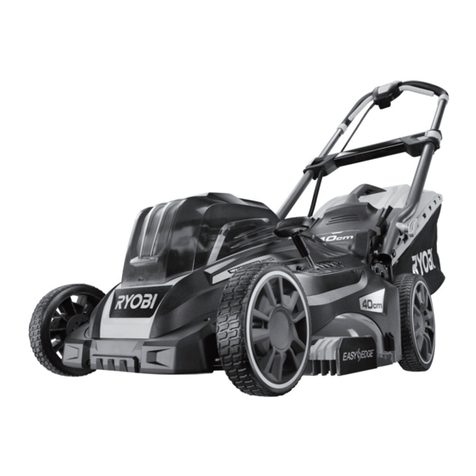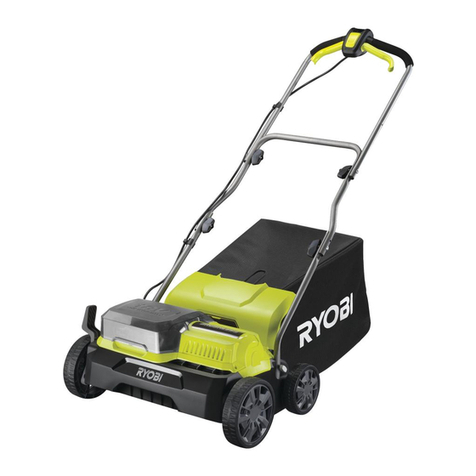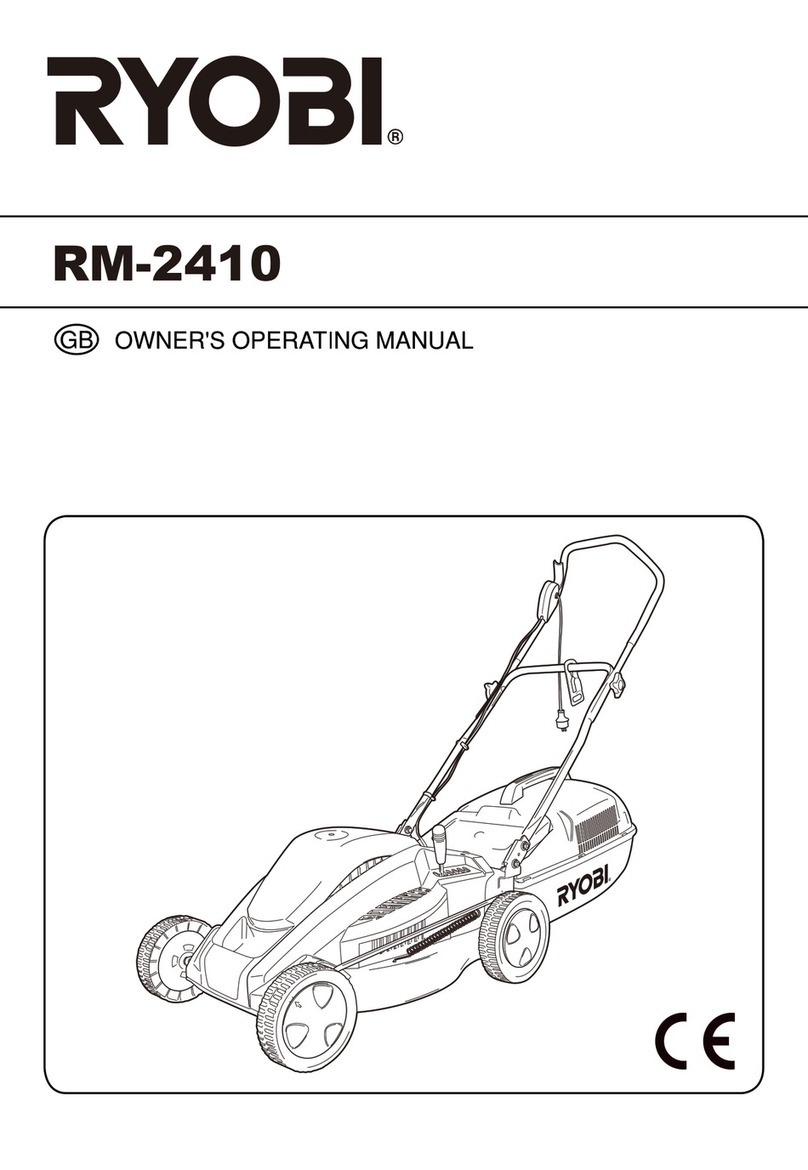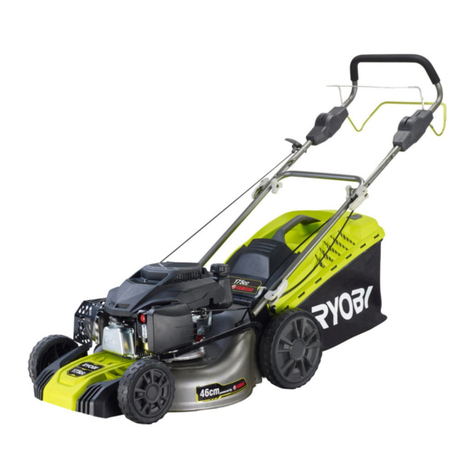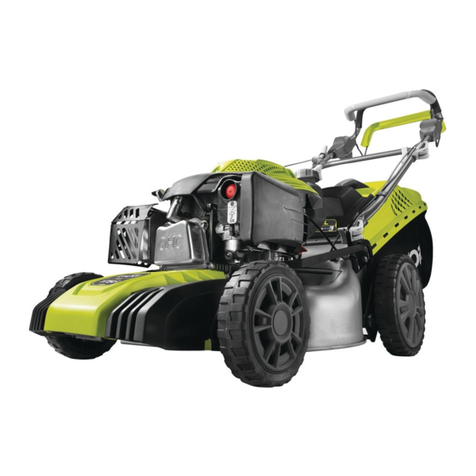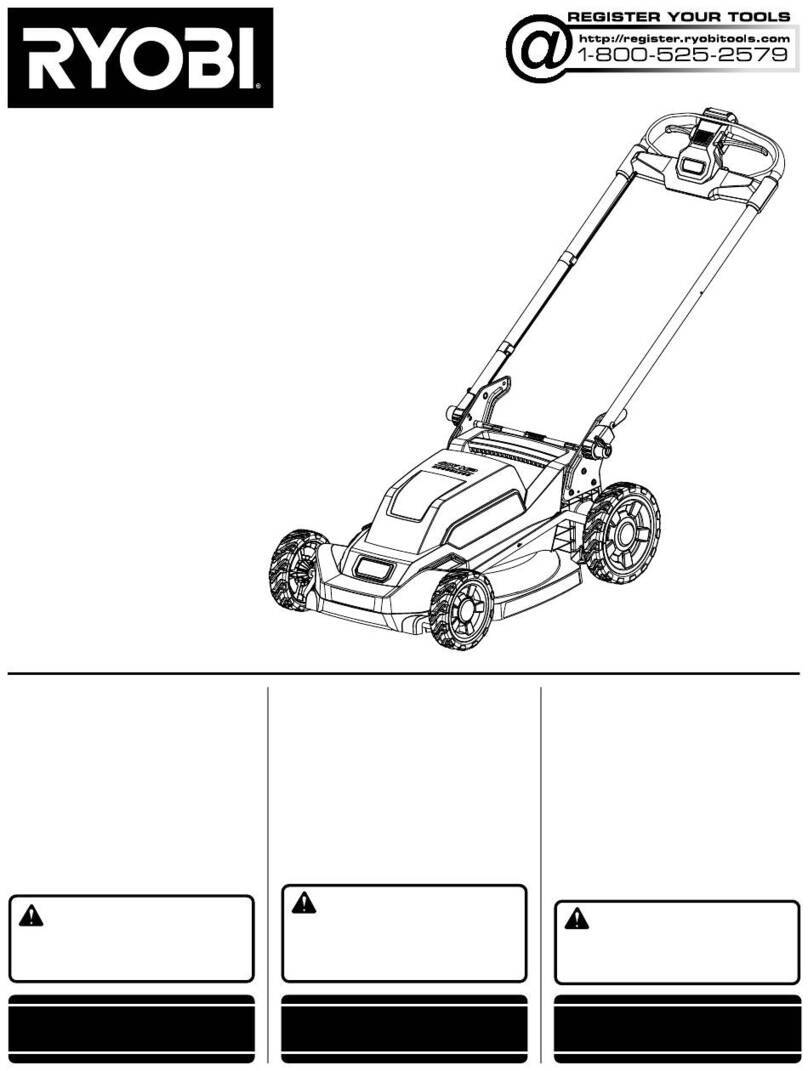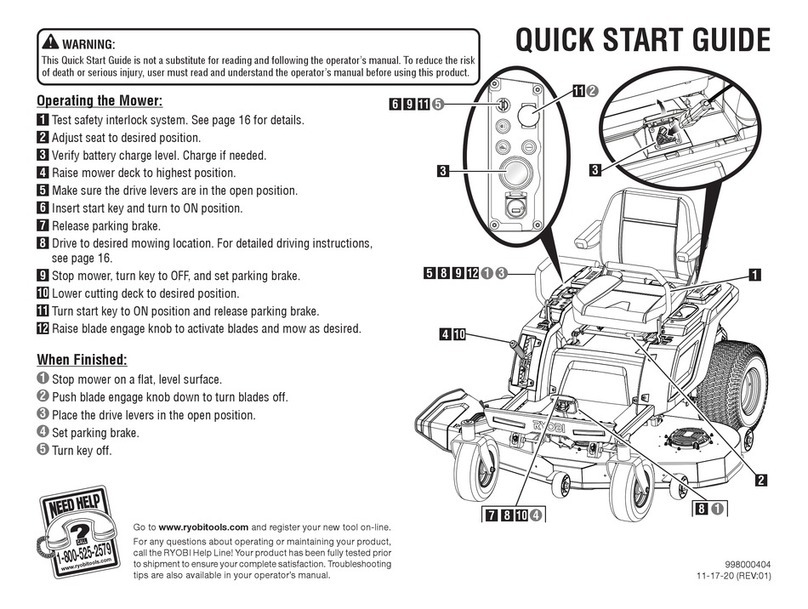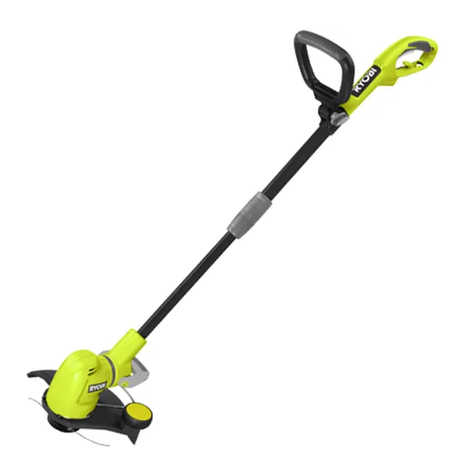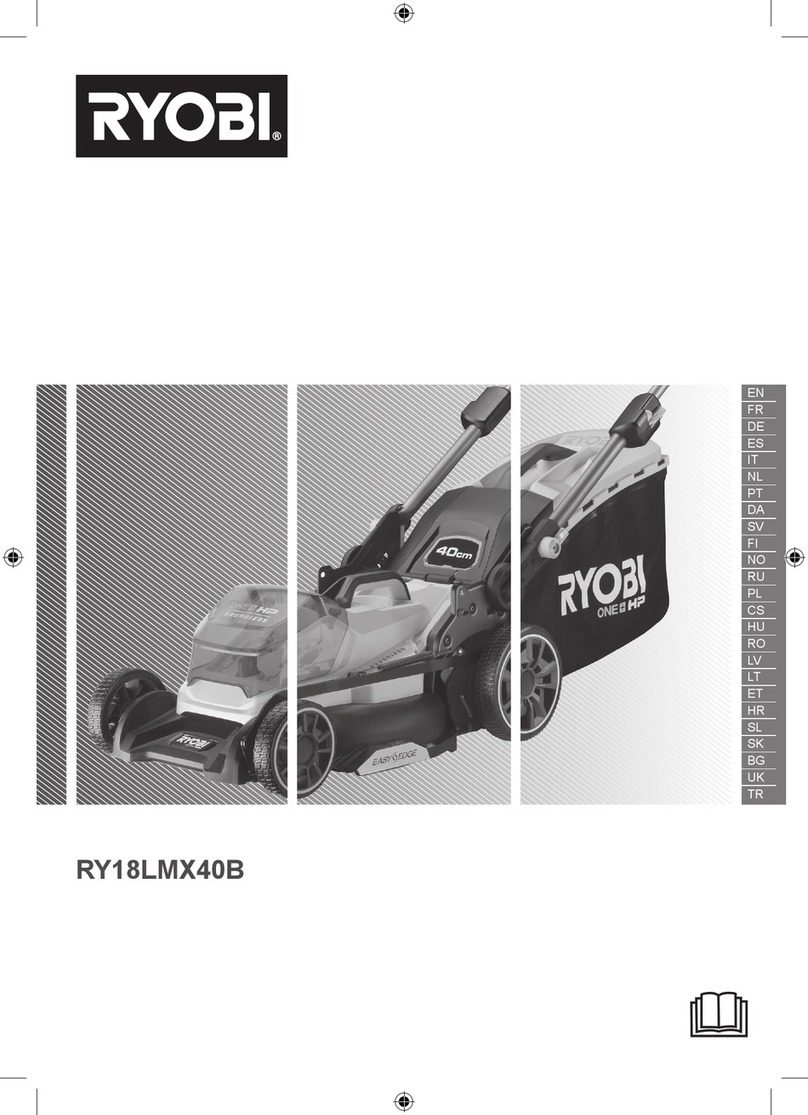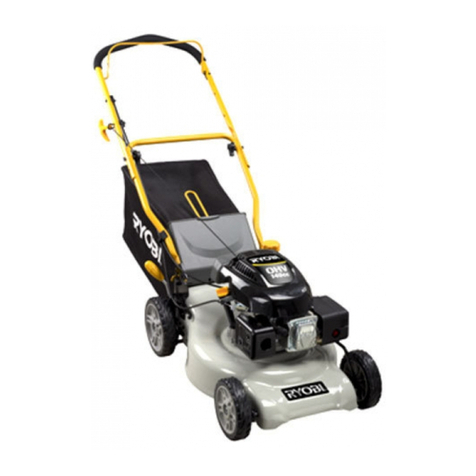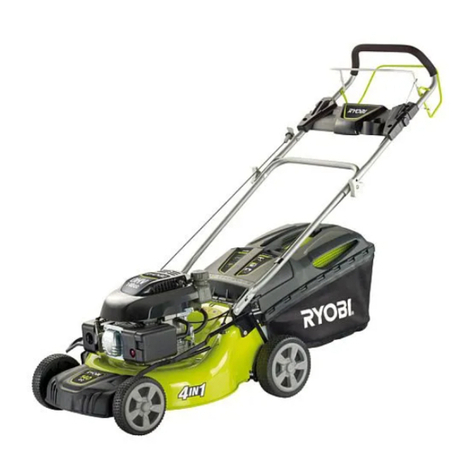
INSTRUCTIONS FOR SAFE HANDLING
1. Make sure that the tool is only connected to the
voltage marked on the name plate.
2. Never use the tool if its cover or any bolts are missing.
If the cover or bolts have been removed, replace
them prior to use. Maintain all parts in good working
order.
3. Always secure tools when working in elevated
positions.
4. Never touch the blade or other moving parts during
use.
5. Never start a tool when its rotating component is in
contact with the workpiece.
6. Never lay a tool down before its moving parts have
come to a complete stop.
7. ACCESSORIES: The use of accessories or
attachments other than those recommended in these
instructions might present a hazard.
8. REPLACEMENT PARTS: When servicing use only
identical replacement parts.
IMPORTANT SAFETY INFORMATION
1. Avoid dangerous environments.
a. Do not operate Trimmer while under the influence of
alcohol, medications, or drugs.
b. Do not operate Trimmer when you are tired.
c. Do not use this Trimmer if you are mentally or
physically unable to operate safely.
2. Inspect Trimmer for damaged parts, and make sure all
fasteners and guards are in place and secure. Replace
any damaged parts.
3. Use only 2.4, 2.7 or 4.0 mm diameter flexible,
nonmetallic line with this Trimmer.
4. Dress properly when operating Trimmer.
a. Always wear heavy long pants, boots, gloves, and a
long-sleeve shirt.
b. Do not wear loose clothing or jewelry that can get
caught in the moving parts of the Trimmer.
c. Always wear gloves and substantial foot wear when
working outside.
d. Always wear protective hair covering to contain long hair.
5. Always wear a face or dust mask if operating in dusty
conditions.
6. Always wear eye protection that meets .
7. Always wear hearing protection which meets or exceeds
ANSI standards.
WARNING!
Read and follow all warnings and safety instructions. Failure
to do so can result in serious injury to you or bystanders.
DANGER!
This Trimmer is designed for use with a non-metallic flexible
string. Never use this Trimmer with other accessories not
specifically approved for use in this manual. Never use
alternative cutting members such as wire or wire-rope,
which can break off and become a dangerous projectile.
THANK YOU FOR BUYING A RYOBI PRODUCT.
To ensure your safety and satisfaction, carefully read through
this OWNER’S MANUAL before using the product.
3
General Safety Rules
SAVE THESE INSTRUCTIONS
WARNING! Read all instructions Failure to follow all instructions
listed below may result in electric shock, fire and/or serious injury.
The term “power tool” in all of the warnings listed below refers
to your mains-operated (corded) power tool or battery-operated
(cordless) power tool.
1) Work area
a) Keep work area clean and well lit. Cluttered and dark areas
invite accidents.
b) Do not operate power tools in explosive atmospheres,
such as in the presence of flammable liquids, gases or
dust. Power tools create sparks which may ignite the dust or
fumes.
c) Keep children and bystanders away while operating a
power tool. Distractions can cause you to lose control.
2) Electrical safety
a) Power tool plugs must match the outlet. Never modify
the plug in any way. Do not use any adapter plugs with
earthed (grounded) power tools. Unmodified plugs and
matching outlets will reduce risk of electric shock
b) Avoid body contact with earthed or grounded surfaces
such as pipes, radiators, ranges and refrigerators. There
is an increased risk of electric shock if your body is earthed or
grounded.
c) Do not expose power tools to rain or wet conditions.
Water entering a power tool will increase the risk of electric
shock.
d) Do not abuse the cord. Never use the cord for carrying,
pulling or unplugging the power tool. Keep cord away
from heat, oil, sharp edges or moving parts. Damaged or
entangled cords increase the risk of electric shock.
e) When operating a power tool outdoors, use an extension
cord suitable for outdoor use. Use of a cord suitable for
outdoor use reduces the risk of electric shock.
3) Personal safety
a) Stay alert, watch what you are doing and use common
sense when operating a power tool. Do not use a power
tool while you are tired or under the influence of drugs,
alcohol or medication. A moment of inattention while
operating power tools may result in serious personal injury.
b) Use safety equipment. Always wear eye protection. Safety
equipment such as dust mask, non-skid safety shoes, hard
hat, or hearing protection used for appropriate conditions will
reduce personal injuries.
4) Power tool use and care
a) Do not force the power tool. Use the correct power tool
for your application. The correct power tool will do the job
better and safer at the rate for which it was designed.
b) Do not use the power tool if the switch does not turn it on
and off. Any power tool that cannot be controlled with the
switch is dangerous and must be repaired.
c) Disconnect the plug from the power source before making
any adjustments, changing accessories, or storing power
tools. Such preventive safety measures reduce the risk of
starting the power tool accidentally.
d) Store idle power tools out of the reach of children and do
not allow persons unfamiliar with the power tool or these
instructions to operate the power tool. Power tools are
dangerous in the hands of untrained users.
e) Maintain power tools. Check for misalignment or binding
of moving parts, breakage of parts and any other condition
that may affect the power tools operation. If damaged, have
the power tool repaired before use. Many accidents are
caused by poorly maintained power tools.
f) Keep cutting tools sharp and clean. Properly maintained
cutting tools with sharp cutting edges are less likely to bind and
are easier to control.
g) Use the power tool, accessories and tool bits etc., in
accordance with these instructions and in the manner
intended for the particular type of power tool, taking into
account the working conditions and the work to be
performed. Use of the power tool for operations different from
intended could result in a hazardous situation.
5) Battery tool use and care
a) Ensure the switch is in the off position before inserting
battery pack. Inserting the battery pack into power tools that
have the switch on invites accidents.
b) Recharge only with the charger specified by the
manufacturer. A charger that is suitable for one type of
battery pack may create a risk of fire when used with another
battery pack.
c) Use power tools only with specifically designated battery
packs. Use of any other battery packs may create a risk of
injury and fire.
d) When battery pack is not in use, keep it away from other
metal objects like paper clips, keys, nails, screws, or
other metal objects that can make a connection from one
terminal to another. Shorting the battery terminals together
may cause burns or a fire.
e) Under abusive conditions, liquid may be ejected from the
battery; avoid contact. If contact accidentally occurs, flush
with water. If liquid contacts eyes, additionally seek
medical help. Liquid ejected from the battery may cause
irritation or burns.
5) Service
a) Have your power tool serviced by a qualified repair person
using only identical replacement parts. This will ensure that
the safety of the power tool is maintained.
c) Avoid accidental starting. Ensure the switch is in the
off-position before plugging in. Carrying power tools with
your finger on the switch or plugging in power tools that have
the switch on invites accidents.
d) Remove any adjusting key or wrench before turning the
power tool on. A wrench or a key left attached to a rotating
part of the power tool may result in personal injury.
e) Do not overreach. Keep proper footing and balance at all
times. This enables better control of the power tool in
unexpected situations.
f) Dress properly. Do not wear loose clothing or jewellery.
Keep your hair, clothing and gloves away from moving
parts. Loose clothes, jewellery or long hair can be caught in
moving parts.
g) If devices are provided for the connection of dust
extraction and collection facilities, ensure these are
connected and properly used. Use of these devices can
reduce dust-related hazards.
THANK YOU FOR BUYING A RYOBI PRODUCT.
To ensure your safety and satisfaction, carefully read
through this OWNER’S MANUAL before using the product.
General Safety Rules
WARNING! Read all safety warnings and all instructions.
Failure to follow the warnings and instructions may result in
electric shock, fire and/or serious injury
Save all warnings and instructions for future reference.
THANK YOU FOR BUYING A RYOBI PRODUCT.
To ensure your safety and satisfaction, carefully read through
this OWNER’S MANUAL before using the product.
6
General Safety Rules
SAVE THESE INSTRUCTIONS
WARNING! Read all instructions Failure to follow all instructions
listed below may result in electric shock, fire and/or serious injury.
The term “power tool” in all of the warnings listed below refers
to your mains-operated (corded) power tool or battery-operated
(cordless) power tool.
1) Work area
a) Keep work area clean and well lit. Cluttered and dark areas
invite accidents.
b) Do not operate power tools in explosive atmospheres,
such as in the presence of flammable liquids, gases or
dust. Power tools create sparks which may ignite the dust or
fumes.
c) Keep children and bystanders away while operating a
power tool. Distractions can cause you to lose control.
2) Electrical safety
a) Power tool plugs must match the outlet. Never modify
the plug in any way. Do not use any adapter plugs with
earthed (grounded) power tools. Unmodified plugs and
matching outlets will reduce risk of electric shock
b) Avoid body contact with earthed or grounded surfaces
such as pipes, radiators, ranges and refrigerators. There
is an increased risk of electric shock if your body is earthed or
grounded.
c) Do not expose power tools to rain or wet conditions.
Water entering a power tool will increase the risk of electric
shock.
d) Do not abuse the cord. Never use the cord for carrying,
pulling or unplugging the power tool. Keep cord away
from heat, oil, sharp edges or moving parts. Damaged or
entangled cords increase the risk of electric shock.
e) When operating a power tool outdoors, use an extension
cord suitable for outdoor use. Use of a cord suitable for
outdoor use reduces the risk of electric shock.
3) Personal safety
a) Stay alert, watch what you are doing and use common
sense when operating a power tool. Do not use a power
tool while you are tired or under the influence of drugs,
alcohol or medication. A moment of inattention while
operating power tools may result in serious personal injury.
b) Use safety equipment. Always wear eye protection. Safety
equipment such as dust mask, non-skid safety shoes, hard
hat, or hearing protection used for appropriate conditions will
reduce personal injuries.
4) Power tool use and care
a) Do not force the power tool. Use the correct power tool
for your application. The correct power tool will do the job
better and safer at the rate for which it was designed.
b) Do not use the power tool if the switch does not turn it on
and off. Any power tool that cannot be controlled with the
switch is dangerous and must be repaired.
c) Disconnect the plug from the power source before making
any adjustments, changing accessories, or storing power
tools. Such preventive safety measures reduce the risk of
starting the power tool accidentally.
d) Store idle power tools out of the reach of children and do
not allow persons unfamiliar with the power tool or these
instructions to operate the power tool. Power tools are
dangerous in the hands of untrained users.
e) Maintain power tools. Check for misalignment or binding
of moving parts, breakage of parts and any other condition
that may affect the power tools operation. If damaged, have
the power tool repaired before use. Many accidents are
caused by poorly maintained power tools.
f) Keep cutting tools sharp and clean. Properly maintained
cutting tools with sharp cutting edges are less likely to bind and
are easier to control.
g) Use the power tool, accessories and tool bits etc., in
accordance with these instructions and in the manner
intended for the particular type of power tool, taking into
account the working conditions and the work to be
performed. Use of the power tool for operations different from
intended could result in a hazardous situation.
5) Battery tool use and care
a) Ensure the switch is in the off position before inserting
battery pack. Inserting the battery pack into power tools that
have the switch on invites accidents.
b) Recharge only with the charger specified by the
manufacturer. A charger that is suitable for one type of
battery pack may create a risk of fire when used with another
battery pack.
c) Use power tools only with specifically designated battery
packs. Use of any other battery packs may create a risk of
injury and fire.
d) When battery pack is not in use, keep it away from other
metal objects like paper clips, keys, nails, screws, or
other metal objects that can make a connection from one
terminal to another. Shorting the battery terminals together
may cause burns or a fire.
e) Under abusive conditions, liquid may be ejected from the
battery; avoid contact. If contact accidentally occurs, flush
with water. If liquid contacts eyes, additionally seek
medical help. Liquid ejected from the battery may cause
irritation or burns.
5) Service
a) Have your power tool serviced by a qualified repair person
using only identical replacement parts. This will ensure that
the safety of the power tool is maintained.
c) Avoid accidental starting. Ensure the switch is in the
off-position before plugging in. Carrying power tools with
your finger on the switch or plugging in power tools that have
the switch on invites accidents.
d) Remove any adjusting key or wrench before turning the
power tool on. A wrench or a key left attached to a rotating
part of the power tool may result in personal injury.
e) Do not overreach. Keep proper footing and balance at all
times. This enables better control of the power tool in
unexpected situations.
f) Dress properly. Do not wear loose clothing or jewellery.
Keep your hair, clothing and gloves away from moving
parts. Loose clothes, jewellery or long hair can be caught in
moving parts.
g) If devices are provided for the connection of dust
extraction and collection facilities, ensure these are
connected and properly used. Use of these devices can
reduce dust-related hazards.
BEFORE OPERATING TRIMMER:
READ AND UNDERSTAND ALL INSTRUCTIONS BEFORE
OPERATING TRIMMER
The safety warnings by themselves do not eliminate any
danger. The instruction or warnings they give are not
substitutes for proper accident prevention measures.
Failure to obey a safety warning can result in serious injury to
yourself or to others.
Do not attempt to operate this tool until you have read
thoroughly and completely understood the safety rules, etc.
contained in this manual.
• Always make a pre-operation inspection before starting the
engine.
• ( You may prevent an accident or equipment damage.)
• To prevent fire hazards provide adequate ventilation.
• Do not place flammable objects close to the engine.
• Know how to stop the engine quickly, and understand the
operation of all controls.
• Never permit anyone to operate without proper instructions.
• Do not place flammable objects such as petrol, matches etc
close to the engine while it is running.
• Refuel in a well-ventilated area with the engine stopped.
Petrol is highly flammable and explosive under certain
conditions.
• Do not overfill the fuel tank. There should be no fuel in the
filler neck.
• Make sure that the filler cap is closed securely
• If any fuel is spilled, clean it up completely and allow petrol
vapours to dissipate before starting the engine
• Do not smoke or allow fumes or sparks where the engine is
refuelled or where petrol is stored
• Exhaust gas contains poisonous carbon monoxide. Avoid
inhalation of exhaust gases. Never run the engine in a closed
garage or confined area.
• Place the engine on a stable surface. Do not tilt the engine
more than 20° from horizontal. Operating at excessive angles
may result in fuel spillage and problems due to the oil level in
the engine.
• The muffler becomes very hot during operation and remains
hot for a while after stopping the engine. Be careful not to
touch the muffler while it is hot.
• To avoid severe burns or fire hazards, let the engine cool
before transporting it or storing it indoors.
• Always stop the engine and disconnect spark plug lead
before any maintenance is carried out
THE ENGINE IS DESIGNED TO GIVE SAFE AND
DEPENDABLE SERVICE IF OPERATED ACCORDING TO
THESE INSTRUCTIONS. READ AND UNDERSTAND THE
OWNER’S MANUAL BEFORE OPERATING THE ENGINE.
FAILURE TO DO SO COULD RESULT IN PERSONAL
INJURY OR EQUIPMENT DAMAGE.


